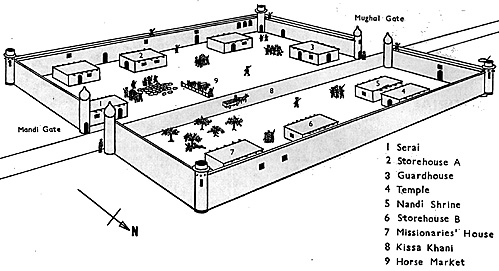SCENARIO
The Gor Khatri market place is i1lustrated in the accompanying sketch drawn by Sergeant Makepeace King R.E., who was later unfortunately killed by dissident tribesmen who ambushed a hospital party en route from Peshawar to the sanatorium in the hills near Cherat. The sketch gives a much simplified impression but nevertheless shows the main features that are important in describing the action that occurred at Gor Khatri on the afternoon of Tuesday, 11 August 1874.
The market place lies in the heart of the old city and is surrounded by a high wall, built of crumbling sun-dried mud bricks of the same colour as the soil - a very dirty brown. The wall is ornamented on the inside and outside with grotesque Hindu figures painted in brilliant colours. The houses around the market place are built of a frame-work of wood filled up with small burnt bricks; the roofs of the houses are flat structures enclosed by wooden frames filled with sun-dried mud to provide a cool sleeping place for the inhabitants in the hot season. There are only two exits from the market place - the Mughal Gate of the Serai and the Mandi Gate, which leads to the Lahori Derwa Gate in the outer wall of the town. The towers at the Mughal Gate contain office accommodation for the Tehsildar (district administrative) staff and to the South of the Gate is a guardroom where a detachment of the 5th Sikh Infantry is posted in case of trouble amongst the unruly tribesmen who are crowded together in the wretched living quarters of the old town.
The walls themselves are some 12 feet or so thick and are honeycombed with small rooms, passages and steps leading to the battlements at the top. At one point in the North Wall there are two windows (see sketch). The more prominent buildings around the market place include the Serai, officially designated as a resting place or Government House for Native Gentlemen, two storehouses containing various boxes, sacks, ropesp and provisions, and the Temple of Gorakhnath, linked to the subsidiary Nandi Shrine. In the South-East corner is a house where two missionaries used to dwell; their efforts met with little success amongst the fiercely independent Frontier tribes and they have recently departed. The market place contains various sectors; in the centre are the grain market and the horse market and in the shade of the Khajur trees near the missionaries' house are thriving stalls selling such goods and produce as grapes, apples, walnuts, ice, turquoise stones, Kabul coats, shawls, socks, swords, chain armour, blankets and articles of Russian leather - all the tribes are encouraged by the Political Department to come to Peshawar to trade, provided that they do not bear arms in the British part of the town (the cantonment and adjacent areas) and do not exercise on the Mall during European hours. The only other feature of note in the market place is the Kissa Khani, a well-paved road running between the two gates and along which a horse-drawn wagon is slowly journeying. The weather is hot and dry and a myriad of sand flies invest the whitish dust that has been blown in by an easterly wind.
Illustration: Gor Khatri Market

Victorian Campaigns on the Northwest Frontier
Part II: If Anyone Can, Bahram Khan (WN 155)
Back to Table of Contents -- Wargamer's Newsletter # 154
To Wargamer's Newsletter List of Issues
To MagWeb Master Magazine List
© Copyright 1975 by Donald Featherstone.
This article appears in MagWeb (Magazine Web) on the Internet World Wide Web.
Other military history articles and gaming articles are available at http://www.magweb.com